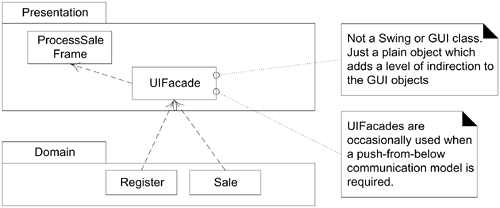30.3. The Model-View Separation Principle
This principle has been discussed several times; this section summarizes it.
What kind of visibility should other packages have to the Presentation layer? How should non-window classes communicate with windows? It is desirable that there is no direct coupling from other components to window objects because the windows are related to a particular application, while (ideally) the non-windowing components may be reused in new applications or attached to a new interface. The is the Model-View Separation principle.
In this context, model is a synonym for the Domain layer of objects. View is a synonym for presentation objects, such as windows, applets and reports.
The Model-View Separation principle[4] states that model (domain) objects should not have direct knowledge of view (presentation) objects, at least as view objects. So, for example, a Register or Sale object should not directly send a message to a GUI window object ProcessSaleFrame, asking it to display something, change color, close, and so forth.
[4] This is a key principle in the pattern Model-View-Controller (MVC). MVC was originally a small-scale Smalltalk-80 pattern, and related data objects (models), GUI widgets (views), and mouse and keyboard event handlers (controllers). More recently, the term “MVC” has been coopted by the distributed design community to also apply on a large-scale architectural level. The Model is the Domain Layer, the View is the Presentation Layer, and the Controllers are the workflow objects in the Application layer.
As previously discussed, a legitimate relaxation of this principle is the Observer pattern, where the domain objects send messages to UI objects viewed only in terms of an interface such as PropertyListener or AlarmListener.
A further part of this principle is that the domain classes encapsulate the information and behavior related to application logic. The window classes are relatively thin; they are responsible for input and output, and catching GUI events, but do not maintain data or directly provide application functionality.
The motivation for Model-View Separation includes:
To support cohesive model definitions that focus on the domain processes, rather than on user interfaces.
To allow separate development of the model and user interface layers.
To minimize the impact of requirements changes in the interface upon the domain layer.
To allow new views to be easily connected to an existing domain layer, without affecting the domain layer.
To allow multiple simultaneous views on the same model object, such as both a tabular and business chart view of sales information.
To allow execution of the model layer independent of the user interface layer, such as in a message-processing or batch-mode system.
To allow easy porting of the model layer to another user interface framework.
Model-View Separation and “Upward” Communication
How can windows obtain information to display? Usually, it is sufficient for them to send messages to domain objects, querying for information which they then display in widgets—a polling or pull-from-above model of display updates.
However, a polling model is sometimes insufficient. For example, polling every second across thousands of objects to discover only one or two changes, which are then used to refresh a GUI display, is not efficient. In this case it is more efficient for the few changing domain objects to communicate with windows to cause a display update as the state of domain objects changes. Typical situations of this case include:
Monitoring applications, such as telecommunications network management.
Simulation applications which require visualization, such as aerodynamics modeling.
In these situations, a push-from-below model of display update is required. Because of the restriction of the Model-View Separation pattern, this leads to the need for “indirect” communication from lower objects up to windows—pushing up notification to update from below.
There are two common solutions:
The Observer pattern, via making the GUI object simply appear as an object that implements an interface such as PropertyListener.
A Presentation facade object. That is, adding a facade within the Presentation layer that receives requests from below. This is an example of adding Indirection to provide Protected Variation if the GUI changes. For example, see Figure 30.16.
Figure 30.16. A Presentation layer UIFacade is occasionally used for push-from-below designs.

